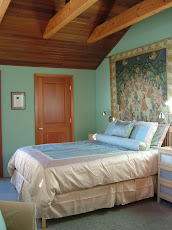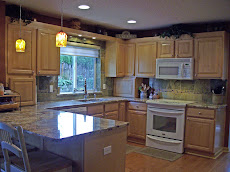Why should you hire an Interior Designer? In my field, I constantly have to market my services to potential clients. Mostly my marketing consists of word of mouth from satisfied clients and people looking for help with their remodel or home build by surfing the internet and finding the design organization I belong to in which my website is linked (
http://www.nwsid.org/).
If they havent already been schooled by their friends and colleagues as to the value of hiring an interior designer or architect, people will ask me why they should hire me to do something they feel they can do themselves. They've watched HGTV and the Style Network and Ty Pennington's show and DIY, etc. They have a talent or knack for design and know some "people". If you have the courage, the stomach, the time and the money for designing and remodeling your own project, go for it! It's a valuable learning experience.
I view my clients doing their own design and contracting like I view doing my own bookkeeping and my taxes. I know how to do it, I've spent hours doing it, I've completed the tasks month after month, year after year, and I've driven myself crazy, I've cried, I've made mistakes, and stolen hours from what I love doing because I thought i was saving myself money and time. That was a bunch of hooey on my part.
"Work smarter, not harder."
" Sometimes it takes money to make money."
These are my mantras for the new year.
I finally hired a bookkeeper and now I can focus on what I love to do every day. I am also not wasting my valuable billable hours working on bookkeeping - that was
not saving money. I was losing money. I finally figured out that for one hour of my work, I could get 2.5 hrs of a bookkeepers time. So for 5 hours a month, I only had to work 2 hours of my time to pay them. And they knew more than me about accounting, bookkeeping, taxes, interest, etc. What a bargain!!! And I didnt have to think about it every day, every month, and every year. My business is more successful today because I am less stressed by not doing what I was not qualified to do.
I digress with my example and will expound upon the comparison of the benefits of the bookkeeper to the designer. Here is the moral of my story in parable form:
"When I meet with my bookkeeper, I hand her a pile of stuff that I know I need for my business, receipts and invoices I've procurred, and items she's requested or I've had to keep track of. She takes that messy disorganized pile I give her twice a month and makes it go away, organized into the accounting program, compiled, reconciled and any other fancy bookkeeping words that come to my mind. She can do this because she is a professional bookkeeper. She has her office for support and resources. She has her education and experience to take all of my information and turn it into something tangible. She has consultants, computer programs and references to assist her in the job of bookkeeping. I dont have these, its not my job, not my career. This is what I pay her to take care of for me so I can make better use of my valuable time. She loves it - I dont know why. It would scramble my brain trying to keep it all together, calculating, organizing, etc. every day for different clients. But she manages to bring together and organize all of my papers, receipts, etc into a functioning bookkeeping file that keeps my business on track and my taxes completed on time every year."
Now instead of using the word bookkeeper, insert the word interior designer and you will see what the value is in hiring an interior designer:
"When I meet with my interior designer, I hand her piles, boxes and folders of items that I am interested in using for my design and/or build. She takes that messy, disorganized pile of my thoughts, research, dreams, and ideas and organizes, deconstructs, plans, shapes, models and creates a tangible vision of how I want my design to be. My designer can do this because she is a professional. She has the education and experience to turn my thoughts into something real. She has the support of her office, trades, resources, and colleagues. My designer has computer programs, cunsultants, and trade references to help her figure out the best design for me. I dont have these - its not my job, not my career. This is why I hire a designer to take care of me and my project so that I can make better use of my valuable time. She loves it - I dont know why. It scrambles my brain just thinking about her doing all that she does for me and with all of her other clients. My interior designer manages to take it all in and produce the most amazing design for me and my home and/or business."
There is value to you to hire an interior designer. The same value there is for you to hire a bookkeeper, a lawyer, or a doctor. Yes, you maybe able to do what they do, but would you want to? No, but they do. Do you know all the laws, codes, legalese, technicalities, etc? No, but they do. Its their job to know and to use that knowledge to help you have a successful business, tax filing, remodel, lawsuit or face lift. You save more money and time hiring a professional to do the job you need done.
The following is an excerpt from NWSID, Southern Chapter for reasons why to hire an Interior Designer for you next project:
Why Hire an Interior Designer?
The following information is provided to you to help you make an informed decision with regard to consideration of hiring an interior designer for your next project. The following are valuable services interior designers can provide to you.
1.Provide solutions: Each project, small or large presents challenges. Whether it is lack of storage, poor traffic flow, color scheme, unusual windows or maximizing light and space.
2.Prevent costly mistakes: So many choices, too many options, and this product over that product. There are so many things that are hard to know unless you have encountered those dozens of times before.
3.Resources: Any design is only as good as its execution. Designers work with the best workrooms, contractors, and fabricators and have the clout to make sure the price matches the quality.
4.Guidance: A designer knows sources well enough to edit the options and offer seasoned advice to guide clients through the myriad of design choices.
5. Convenience: Designers save you shopping time and work on-site. We bring the “store” to you.
6.Set priorties: A Designer will help allocate your “design dollars” and how best to spend your money now and plan for future phases of your design project.
7. Liaison/Advocate: Designers work with trades-people and manufacturers regularly and have more leverage to get things repaired or replaced when necessary.
8. Working through opposing taste: Designers can be the third party to join taste and style between husband and wife or significant other.
9. Get the job done: Designers see to it that everything is completed. Your complete satisfaction is their best referral.
So when considering your next design or remodel project, consider the assistance of an interior designer. Not all Interior Designers work the same so check out design organization websites, surf the net for interior designers in your area, ask your friends for referrals, and make sure to interview several designers that fit your needs before settling on one. Designing and altering your home is a personal project and you want the person that fits best with you, your partner and/or your family.
How to Hire an Interior Designer - next time












